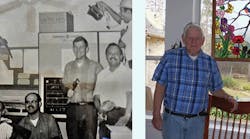An interesting commonality among four of our five inductees into the Control Process Hall of Fame this year is involvement in the development of model predictive control (MPC) algorithms or its variety of technology successors in the field of advanced control and optimization. So it only seems fitting that we save for last our profile of one of the earliest MPC pioneers. That, plus "Ramaker" comes conveniently last in an alphabetical listing.
Brian Ramaker was indeed on the front lines of MPC development at Shell Oil Co., and co-authored the original patents for Dynamic Matrix Control with colleague Charles Cutler (and fellow Hall of Famer), who left to start DMC Corp. Ramaker stayed the course with Shell, and is now retired and living north of Houston. As a bachelor-degreed chemical engineer, he had taken a first job with Ethyl Corp., developing a process for making straight-chain alcohols. The pilot-plant process was “quite nasty,” Ramaker recalls, and he was soon looking for other, potentially less hazardous employment.
This year, we welcome five new members to the Control Process Automation Hall of Fame.
- Thomas A. Badgwell, Chief Technology Officer, Collaborative Systems Integration
- Lorenz (Larry) Biegler, Covestro University Professor, Dept. of Chemical Engineering, Carnegie Mellon University
- Andy Chatha, President & CEO, ARC Advisory Group
- Thomas E. Marlin, Professor Emeritus, Dept. of Chemical Engineering, McMaster University
- Brian L. Ramaker, Shell Oil Co. (retired)
A summer student invited him to dinner, where he happened to meet a new professor at nearby Louisiana State University by the name of Cecil Smith—who also happens to be a fellow Process Automation Hall of Famer. “He asked me, ‘If I could get you a fellowship, would you come back to school?” Ramaker said. “Six weeks later, Smith called to say he lined up a full ride fellowship if I’d come back to school. My wife was eight months pregnant, but I quit my job and went to work with Cecil.”
So, Ramaker embarked on what turned into a long and productive career in process control, just as the new digital computer technology was first being applied to the challenge. LSU was one of the hotbeds of academic work in the field, and Shell Oil was at the leading edge of implementation. Ramaker landed at the company’s Houston research lab, and one of his first jobs was to work out the controls and optimization of a cat-cracker plant. “The best we could do at the time was an array of single-loop controllers backed by a bunch of logic to implement linear program results that identify which constraints to push up against. ” Ramaker says. “It was a bit of a strange implementation, but it worked. This was 1968."
In 1970, Ramaker transferred to the Shell Refinery in Norco, La., to join Cutler inputting a computer system on their cat cracker. Soon after it was installed, the operators went on strike and the staff ran the unit for six weeks without interruption. “Charlie and I got kind of bored just watching the unit run, so we got to talking about his ideas for a multivariable controller,” Ramaker recalls. “We both agreed, let’s try something new.
“In a couple of days, I had the multivariable control programmed. We tried it on a single variable to test out its performance. Everything worked as expected. We had one remaining problem: the controller needed to recognize process constraints and not exceed them. But a new employee, David Prett, solved this problem, so we were now ready to try it on a whole unit.
"A new opportunity became available on a cat cracker at another refinery. It was decided to put multivariable on the whole reactor and regenerator system. This was our first application of dynamic matrix control.”
Cutler left soon afterward to found DMC, but Ramaker wasn’t much up for the constant travel expected of a contractor, so he stayed at Shell and his group soon grew to 25—all working on implementing advanced control.






